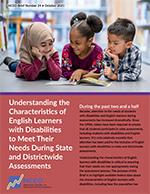Since the 1990s, states have been mandated to ensure the inclusion of all students in assessments, including students with disabilities and English learners. English learners with disabilities are students who are in both of these groups. The National Center on Educational Outcomes (NCEO) has a brief titled Understanding the Characteristics of English Learners with Disabilities to Meet Their Needs During State and Districtwide Assessments (NCEO Brief #24) that highlights federal data on the characteristics of English learners with disabilities, and shows changes in the population over time. Three aspects are explored:
- the percentage of all students with disabilities identified as English learners
- the disability categories of English learners with disabilities
- the classroom placements of English learners with disabilities
The Brief also highlights the importance of understanding classroom placements to ensure inclusive and effective education for English learners with disabilities. The Brief concludes with several implications meeting the needs of English learners with disabilities during state and districtwide assessments:
- There is the need for tailored professional development for educators and school administrators on English learners with disabilities.
- It is important for individualized education program (IEP) teams to have guidance on making assessment participation decisions for English learners with disabilities.
- There is a need for the creation of state policies for assessment accessibility features and accommodations for this student population.

